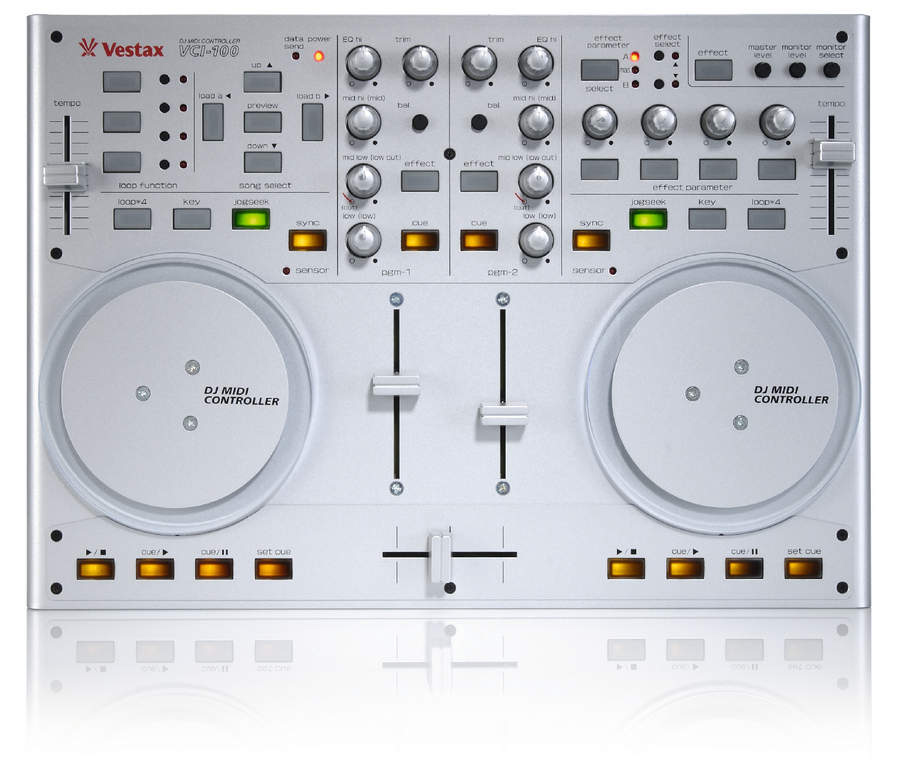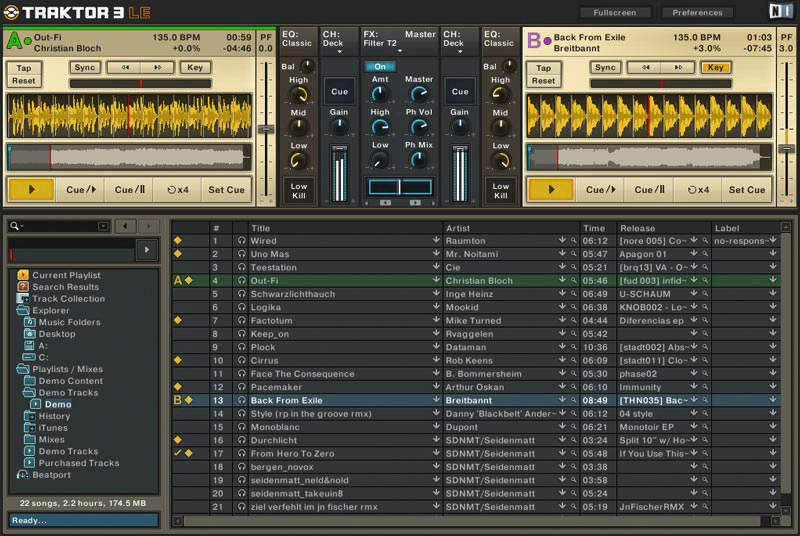MusicRadar Verdict
It looks and feels great, but in action, the VCI-100 is flawed. What's more, there are several similar products on the way...
Pros
- +
Solid construction. Plenty of control options. USB-powered. Software templates.
Cons
- -
Quite heavy and large. Expensive for what you get. Not great for scratching. Too cramped.
MusicRadar's got your back


It seems like every hardware manufacturer in the industry is releasing a USB MIDI controller for DJs. But few have Vestax´s pedigree, so plenty of people are getting quite excited about the VCI-100.
This new control surface is built around two virtual decks. Each of these has its own jog wheel, EQ controls (high, low, high-mid and low-mid), channel faders, trim, pitch, looping, transport and effects controls. There´s also a crossfader with adjustable curve, plus monitoring and master controls and a selection of other less critical functions to aid navigation. All of which sounds good, if not exactly unique.
Out of the box
Lift the VCI-100 out of its box and you discover that it´s very heavy indeed. In fact, it´s built like the proverbial brick-privy. This, of course, is a double edged sword... but more on that later.
All the knobs and faders feel nice and substantial, so we suspect the VCI-100 will be able to handle its fair share of backpack trips. But enough cosmetic analysis - how does the thing work when you plug it in?
Vestax supply control mapping templates for various host programs, meaning that all of the unit´s functions are pre-mapped and ready to use. This means you can dive right in, though you can make your own assignments should you wish. The VCI-100 is plug ´n´ play, taking its power either over USB or from a separate power supply (not included). This means that setup is simple, though because the sockets are on the back of the VCI-100, the advertised ‘unit-in-front-of-laptop´ configuration won´t actually work. But enough quibbling...
In practice
Try scratching on the VCI-100 and you realise that you can do it, but not brilliantly. Response is OK, but the small size of the jog wheels means that you simply don´t have enough fine control. The start-up time, too, is a little limiting - when you release a jog wheel, the playing track starts up slowly (and audibly). Try to give it a nudge to compensate and it goes too fast (again, audibly) before settling down to the right speed. So, all but rudimentary scratching is a no-no.
Fortunately, the jog wheels can be used for other purposes, too. Each one has two parts: a metal inner ring and a clear plastic outer. By touching only the outer, a wheel can be used to make tempo-nudge adjustments, while touching the inner metal section engages the scratching function (you know when this happens because the backlighting changes colour).
So, what other goodies does the VCI-100 have to offer? Well, there´s a good range of buttons and knobs for effects and looping, and having them preassigned and labelled does make life nice and easy.
Unfortunately, though, there are a few important things that the VCI-100 doesn´t have. It would really benefit from the inclusion of an audio interface with built-in headphone socket, for example - something that would make the £419 price tag seem a little more palatable. A brighter interface would also help; there are lots of LEDs all over the place, but once the lights go down, it´s pretty hard to make out any of the lettering.
Verdict
Ultimately, we reckon the VCI-100 has a hole below the waterline before it even sets sail. The thing is, it doesn´t really plug any gaps in the current market. If you aren´t a scratch DJ and you use modern DJing software, you simply don´t need jog wheels - all the beat-mixing is almost automatic. And if you don´t need jog wheels, you´d have to be pretty daft to buy a huge hulking unit that´s made twice as heavy and large by the inclusion of said platters.
If you are a scratch DJ, the problem is that the VCI-100 simply isn´t up to, ahem, scratch. The jog wheels are too small for precise control (as are the pitch faders, in fact), there are problems when you release them, and the whole interface is so cramped that any serious attempt at a marathon scratching session will leave your hands feeling crumpled and pained. The bottom line is that scratch DJs will get much more joy out of a timecoded vinyl system.
All in all, then, the VCI-100 has to go down as a big disappointment - especially when you consider its high price. It´s a good looking and well-built piece of kit, certainly, but it simply doesn´t work as well as we hoped it would. The search for the perfect MIDI DJ controller continues.
MusicRadar is the number one website for music-makers of all kinds, be they guitarists, drummers, keyboard players, DJs or producers...
- GEAR: We help musicians find the best gear with top-ranking gear round-ups and high-quality, authoritative reviews by a wide team of highly experienced experts.
- TIPS: We also provide tuition, from bite-sized tips to advanced work-outs and guidance from recognised musicians and stars.
- STARS: We talk to musicians and stars about their creative processes, and the nuts and bolts of their gear and technique. We give fans an insight into the craft of music-making that no other music website can.
“We were arguing a lot and we were miserable”: How Green Day exceeded expectations with their most ambitious song
"There’s plenty for us guitarists to learn – and ‘less is more’ is the overriding lesson": how to play like George Harrison on The Beatles' Abbey Road
“They didn’t like his bikini underwear”: Prince’s support sets for the The Rolling Stones in 1981 are remembered as disastrous, but guitarist Dez Dickerson says that the the crowd reaction wasn’t as bad as people think










